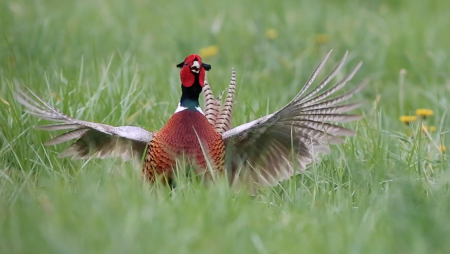Because of its abundant open space, Detroit has a thriving ring-necked pheasant population. But what does coming development mean for this iconic bird and its future in the Motor City?
By Diane Cheklich and Dan Wanschura
The following story is adapted from an episode of Points North, a narrative podcast about the land, water, and inhabitants of the upper Great Lakes. Listen to more episodes at pointsnorthpodcast.org.
The sun shines down brightly on 10-year-old Brandon Halthon and his seven-year-old brother Jaxon Head, as they tip-toe along, trying to sneak up on a ring-necked pheasant.
“I see him from right here,” says Brandon, holding a pair of binoculars.

Brothers Jaxon Head (left) and Brandon Halthon search for pheasants in their Detroit neighborhood. (Credit: PHEASANTS OF DETROIT)
The birds are mostly brown; they have long tail feathers, and are a little bigger than a chicken. Males have a white ring around their necks and colorful blue-green heads with bright red patches around their eyes.
“I don’t see him, bro-bro, do you?” Brandon declares as the bird darts amongst knee-high grass; a perfect habitat for pheasants to hide.
“I see it! I see the tail,” Jaxon exclaims.
Then with a sudden flutter, the pheasant launches into the air mere feet from the boys.
“Oh, dang! That scared me,” says Jaxon. “He was right there? I should have known he was right there.”
Pheasants are usually found in rural fields and prairies. But Brandon and Jaxon aren’t in the countryside. They’re smack dab in Detroit, Michigan. Even with all its traffic and buildings, the city has a thriving pheasant population. In fact, the bird has become an icon here.
“Detroit is probably the only major city in the whole U.S. that has a population of wild game birds walking around, like literally on urban streets.” said Diane Cheklich, who co-produced a documentary highlighting Detroit’s pheasants. “You don’t see pheasants in New York or Chicago or San Francisco, so, it’s sort of a cool thing that’s unique to Detroit.”
If you didn’t know there are pheasants in Detroit, you’re not alone. Despite many people’s surprise, pheasants have been in Detroit for decades.
In the 1950 census, Detroit was the fifth largest city in the country. Since then, its dropped to 27th. As a result, parts of the city are now vacant and overgrown. But as people moved out, pheasants moved in.
“Any parks or parking lots that tend to get tall grasses and things like that, that would be their preferred habitat and we actually have a lot of that here in the city of Detroit,” said Natalie Cypher, who works for the Michigan Department of Natural Resources. For the past few years, she’s organized pheasant walks every spring.
Ring-necked pheasants were brought to North America from Asia in the 1880’s as a game bird. They were and still are popular to hunt. They’re also popular with curious birders.

A ring-necked pheasant walks along the rail tracks in Detroit. (Credit: PHEASANTS OF DETROIT)
Cypher thinks the birds might have gotten to Detroit by following railway corridors; direct lines into the city with plenty of brushy areas for food and cover.
However it happened, pheasants have become part of life for many Detroiters. That’s true for Bernadine Head, who has lived in the city her whole life.
“That’s my alarm clock,” said Head in reference to a male pheasant she hears most mornings. “He wakes me up every morning, and when he wakes me up, I got to get up because he’s not going to let you go back to sleep.”
It’s a similar experience for Diane Van Buren, who lives on Detroit’s east side.
“Five o’clock in the morning, he starts crowing,” said Van Buren. “So you know – Phil’s up, so it must be time to get up and get the day on.”
“Phil” is the nickname she gave the pheasant hanging around her house. Before she bought the house, Van Buren said she noticed Phil walking along the side yard next to the property.
“I said, ‘We have to buy this house,’ because there can’t be anything more remarkable than seeing a pheasant walking alongside the house,” she recalled. “So the rest is history – we bought the house.”
Pheasants are also a popular muse for artists in the city, as murals of the bird have popped up on everything from fences to stores, to restaurants – even houses. A Detroit-based brewery even named itself Faison which is French for “pheasant.” And for Andrew Koper who plays on an adult soccer team from the Corktown neighborhood, “Pheasants” sounded like the perfect team name.
“We’re not going to be the Lions, we’re not going to be the Tigers, or some fierce animal. Well, let’s be the Pheasants – kind of an ironic joke,” Koper recalled. “We loved it; it was really funny; it was very Detroit.”

Members of the Corktown Pheasants high-five during a soccer game. The team named itself the Pheasants due to the birds living in their neighborhood. (Credit: PHEASANTS OF DETROIT)
But all the vacant land that makes Detroit appealing to pheasants is also appealing to developers, and while investment in a city can be good, it also worries some residents.
“When you have the development of an area like Detroit, the development is usually based on attracting new people to the neighborhood, and we wanted the development to be based on the people that are in the neighborhood,” said Tricia Talley, the executive director for the North Corktown Neighborhood Association.
The NCNA is one organization trying to embrace development, while also but also advocating for the things that make their neighborhood unique. And that includes the pheasants.
“A lot of our concentration was, ‘If you’re going to build housing here, we want the housing to be affordable and we also want to preserve open space,’” said Talley. “That’s where the bird habitat comes in.”

Pheasants have endeared themselves to many Detroiters by representing a connection to the city and the natural world. (Credit: PHEASANTS OF DETROIT)
Talley wants to make sure pheasants always have the space to thrive in Detroit. That’s why she’s working to establish a bird sanctuary within her community. It would be roughly half an acre, made up of six, vacant land parcels: natural habitat for all sorts of wildlife complete with trails and benches.
“It’s beneficial for the mental health of the neighborhood,” Talley said. “The physical health – being able to have somewhere to actually go and decompress, especially after going through something like the pandemic.”
The estimated cost of purchasing the land is around $100,000. Talley is trying establish the sanctuary under a community land trust which would protect it from future development and give it a non-profit status.
Other residents and community groups are working on similar conservation projects all over Detroit, and the city’s parks department is doing the same.
In 2022, Detroit Parks & Rec released its strategic plan for the next ten years. That was shaped by extensive community outreach and feedback, and access to nature is high on the priority list. It includes goals like having a park within a 10 minute walk for every city resident, and creating 1,500 acres of natural space with wildlife in mind.

A colorful male ring-necked pheasant walks through the snow in the backyard of a Detroit neighborhood. (Credit: PHEASANTS OF DETROIT)
The ring-necked pheasant has become a sort of poster child for this movement. It serves as an organic connection to Detroit and natural spaces that resonates with many.
“I’ve always thought the pheasants in our neighborhood was a sign of good things to come,” said Talley. “Because so often, people think of Detroit of just this hardcore, urban landscape where survival is just difficult, and it’s not like that. I think the pheasants sort of soften the landscape of the neighborhood.”
Some might see vacant, unused land as a sign of a city’s regression; but for many Detroiters, it represents something else: habitat for pheasants, the foundation for a healthy community, and a different way for Detroit to lead once again.
Dan Wanschura is the host and executive producer for Points North, a narrative podcast about the land, water, and inhabitants of the Great Lakes. He loves telling sound-rich stories that mix information with emotion, and has won numerous national awards for his reporting. Dan lives in Traverse City, Michigan with his wife and young son.






